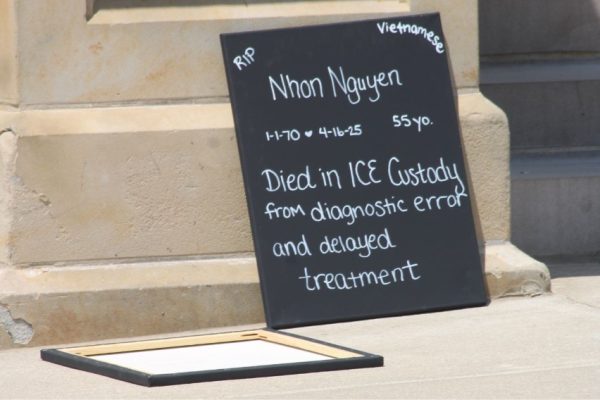Residents resist changes to dining plans
Chartwells’ Mark McCormic speaks about newly proposed meal plans for residents.
University Housing is considering a new dining system that would eliminate transfer meals and increase declining points, in hopes of reducing traffic in the Pioneer Food Court.
The Residence Halls Association hosted two townhall meetings last week, during which students voiced their opinions and heard from Chartwells higher-ups about the proposed changes. The first meeting was held Jan. 31 and focused on the proposed system, while the second took place Feb. 1 and focused on food quality.
The current meal plans
The existing meal plans operate on a system of meals in the Vandenberg Dining Center; transfer meals in the Pioneer Food Court, Tilly’s cafe in Oak View Hall or the Oakland Center’s Bear Cave; and declining points, also called “meal dollars.”
Residents choose from three plans:
- 285 total meals and $50 in declining points
- 210 total meals and $100 in declining points
- 150 total meals and $250 in declining points
Regardless of which meal plans they choose, all students have seven transfer meals per week, which they can use at Panda Express, Chick-Fil-A, Moe’s Southwest Grill, Create, Subway, Tilly’s or the Bear Cave.
Declining points can also be used to purchase meals from these locations, or they can be put toward snacks or drinks from the various shops and cafés on campus.
The average dollar equivalent of a transfer meal is $7.46, according to a handout distributed at the Jan. 31 RHA meeting.
If students were to use their complete declining points balance on meals — leaving no points leftover for miscellaneous purchases — the existing meal plans would, including total meals and meals from declining points, equate to 291.7, 223.4 or 183.5 meals per semester.
The meeting handout said: “Every transfer meal used creates one less Vandenberg meal swipe. Total meals are a wash between Vandenberg meals and Food Court meals.”
The proposed meal plans
In the newly proposed dining system, transfer meals would be removed, but there would be a vast increase in declining points.
Instead of $50, $100 or $250 in declining points, the new plans would offer the following:
- 300 meals in Vandenberg Dining Center and $250 in declining points
- 225 meals in Vandenberg Dining Center and $325 in declining points
- 165 meals in Vandenberg Dining Center and $425 in declining points
According to the handout, the total meal equivalencies of these plans would be 333.5, 268.5 and 221.9 per semester, respectively.
James Zentmeyer, director of University Housing, said part of the reason for the proposed change is to cut down on traffic in the Pioneer Food Court.
“Transfers only work in the food court,” Zentmeyer said during the first townhall meeting. “We need to see what to do about the overcrowding.”
He explained that, in the past, when residents were limited to three transfer meals per week, the average student used one-and-a-half per week. Now, with the limit at seven per week, the average resident uses about three.
“You get to decide the size of the meal [with the proposed plan],” Zentmeyer said.
Students expressed various concerns during the meeting. One student brought up that the equivalent of a transfer meal in Tilly’s costs over $10 and said the pricing is unfair.
Mark McCormic, district manager of Chartwells, said there are “weird outliers,” and the intent of the new plan isn’t to overcharge students, but to provide flexibility.
“We aren’t this unanswerable cooperate force over in the OC,” McCormic said. “We want to hear your opinion seriously.”
Throughout the meeting, multiple students pointed out problems with the math on the handout, claiming that the proposed increased declining balances are not equivalent to seven transfer meals per week.
At one point, multiple people in the audience said, “It doesn’t add up.”
McCormic said that it isn’t possible to “create a meal plan for outliers, and this plan meets the needs of the average student.”
He also said that this plan is “almost equivalent.”
Student Sarah Benson asked what options would be available for residents who use all of their transfer meals and rely on the food court for their meals.
“So, it depends on what plan you get,” McCormic responded. “If you want to do the 150 meals, with 425 declining dollars, that’s 850 in your academic year for use in retail. It does a lot. Most people would be fine with that, and there are some outliers like this young lady, who probably might have some behavioral changes when she’s out of money in October . . . You still have to make choices in life, right? Do you want flexibility, or do you want no flexibility?”
McCormic said that perhaps a system could be created in which students have two-thirds of their declining points available from the beginning of the semester and then receive the other third partway into the semester, as a sort of “speed bump” to keep students from using up all of their declining points too quickly.
“You might run out for a week or two, and hopefully that’s not, you know, starvation for somebody, but that might be one kind of solution to that problem,” he said.
Throughout the entire meeting, there were no students who stood up and spoke in support of the proposed meal plan changes.
Quality concerns
The second townhall meeting focused on food quality. It was held last Wednesday during lunch and had a much smaller turnout than the first.
Students brought up concerns of food poisoning.
Zentmeyer responded that students were most likely experiencing stomach viruses and said there would be more than one isolated incident if it were food poisoning.
“On an ongoing basis, Chartwells is always testing its food,” he said.
RHA streamed both meetings on its Facebook page, where they can both be watched in full.










